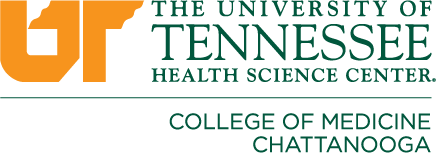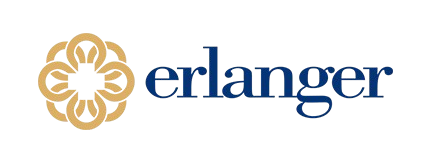Neurology Residency Curriculum
PGY-1 Preliminary Medicine Internship Block Schedule
Site #1 is Erlanger Health System (adult hospital)
| Block Number | Site Number | Rotation Name |
| Block 1 | Site 1 | Neurology |
| Block 2 | Site 1 | Internal Medicine Inpatient |
| Block 3 | Site 1 | Critical Care (ICU) |
| Block 4 | Site 1 | Cardiology |
| Block 5 | Site 1 | Internal Medicine Inpatient |
| Block 6 | Site 1 | Internal Medicine Inpatient |
| Block 7 | Site 1 | Neurology |
| Block 8 | Site 1 | Critical Care (ICU) |
| Block 9 | Site 1 | Neurology |
| Block 10 | Site 1 | Neurosurgery |
| Block 11 | Site 1 | Emergency Medicine |
| Block 12 | Site 1 | Internal Medicine Inpatient |
| Block 13 | Site 1 | Neurology |
Advanced Neurology Residency Block Schedule (PGY-2, PGY-3, and PGY-4)
Site 1 = Erlanger Health System (adult hospital)
Site 2 = Children's Hospital at Erlanger)
Neurology 1st Year (PGY-2 Level) Block Schedule
| Block Number | Site Number | Rotation Name | Percent of Rotation that is Outpatient |
| Block 1 | Site 1 | Ambulatory Night Float | 50% |
| Block 2 | Site 1 | General Neurology | 5% |
| Block 3 | Site 1 | Stroke | 5% |
| Block 4 | Site 1 | EMG | 90% |
| Block 5 | Site 1 | General Neurology | 5% |
| Block 6 | Site 1 | Ambulatory Night Float | 50% |
| Block 7 | Site 1 | General Neurology | 5% |
| Block 8 | Site 1 | Stroke | 5% |
| Block 9 | Site 1 | Ambulatory Night Float | 50% |
| Block 10 | Site 1 | General Neurology | 5% |
| Block 11 | Site 1 | EEG | 29% |
| Block 12 | Site 1 | Stroke | 5% |
| Block 13 | Site 1 | Ambulatory Night Float | 50% |
Neurology 2nd Year (PGY-3 Level) Block Schedule
| Block Number | Site Number | Rotation Name | Percent of Rotation that is Outpatient |
| Block 1 | Site 1 | Stroke | 5% |
| Block 2 | Site 1 | EEG | 20% |
| Block 3 | Site 1 | General Neurology | 5% |
| Block 4 | Site 1 | Night Float / Ambulatory |
50% |
| Block 5 | Site 1 | Stroke | 5% |
| Block 6 | Site 2 | Neuro-Pediatrics | 30% |
| Block 7 | Site 1 | Ambulatory / Night Float |
50% |
| Block 8 | Site 1 | General Neurology | 5% |
| Block 9 | Site 1 | Neuro-Pediatrics | 30% |
| Block 10 | Site 1 | Stroke | 5% |
| Block 11 | Site 1 | General Neurology | 5% |
| Block 12 | Site 1 | Ambulatory/ Night Float |
50% |
| Block 13 | Site 1 | EMG | 50% |
Neurology 3rd Year (PGY-4 Level) Block Schedule
| Block Number | Site Number | Rotation Name | Percent of Rotation that is Outpatient |
Percent of Rotation that is Research |
| Block 1 | Site 2 | Neuro-Pediatrics | 30% | |
| Block 2 | Site 1 | General Neurology | 5% | |
| Block 3 | Site 1 | Elective / Night Float |
40% | 10% |
| Block 4 | Site 1 | Psychiatry | 40% | |
| Block 5 | Site 1 | Stroke | 5% | |
| Block 6 | Site 1 | EEG | 20% | |
| Block 7 | Site 1 | Stroke | 5% | |
| Block 8 | Site 1 | EMG | 90% | |
| Block 9 | Site 1 | General Neurology | 5% | |
| Block 10 | Site 1 | Stroke | 5% | |
| Block 11 | Site 1 | Elective / Night Float |
40% | 10% |
| Block 12 | Site 1 | Elective | 20% | |
| Block 13 | Site 1 | Elective | 20% |
Curriculum Description
- ACGME Program Requirements for a Neurology Residency (effective July 1, 2022)
- ACGME Neurology Resident Milestones (effective July 1, 2021)
- American Board of Psychiatry and Neurology Core Competencies Outline
Internal Medicine Internship (PGY-1)
Our program as we have proposed it to the Neurology RRC, is designed as an Advance Neurology Residency with separate preliminary year and neurology years. Given RRC approval, the internship year will be comprised of 13 four-week block rotations based at our primary clinical training site, Erlanger Health System:
-
- Four blocks (four weeks each) of experience on Inpatient Internal Medicine Teams
- Two blocks (four weeks each) of clinical experience in Critical Care Medicine (ICU)
- Four blocks (four weeks each) of experience in Inpatient and Outpatient Neurology
- One block (four weeks) of experience in Cardiology
- One block (four weeks) of experience in Neurosurgery
- One block (four weeks) of experience in Emergency Medicine
First Year of the Neurology Residency (PGY-2)
-
- The purpose of the first year is to provide Residents with broad patient exposure and comprehensive training in the basics of clinical neurology. These include data gathering, case formulation, diagnosis and management of both inpatients and outpatients.
- To achieve this goal, Residents spend most of their time caring for inpatients on the Neurological Services of our primary clinical training site and major affiliated partner, Erlanger Health System.
- Four blocks (four weeks each) spent on General Neurology
- Three blocks (four weeks each) spent on Stroke
- Four blocks (four weeks each) spent on Ambulatory Neurology and Night Float
- One block (four weeks) is spent on an EEG rotation
- One block (four weeks) is spent on an EMG rotation
- In January of the PGY-2 level of training, Neurology Residents will begin an one-year, online longitudinal course required by the main UTHSC campus called "Residents as Educators." This training provides instruction to develop better teaching skills as residents train medical students during the required Neurology Clerkship as well as more junior residents as they progress throughout the residency program.
- Each PGY-2 is given access to the Emergency Neurologic Life Support (ENLS) course through the Neurocritical Care Society. Certification should be completed by the end of July of the PGY-2 level of training.
- The Statewide GME Programs of the University of Tennessee require that all residents must successfully pass the USMLE Step 3 (or equivalent) in order to be promoted to the PGY-3 level of training.
Second and Third Years of the Neurology Residency (PGY-3 and PGY-4)
- During their second year of the Neurology Residency, residents refine the skills and consolidate the knowledge gained during their first year. Each Resident's intellectual growth and maturity are strengthened by handling cases of increasing diagnostic and therapeutic complexity while working closely with Neurology Faculty.
- Three blocks (four weeks each) are spent rotating on General Neurology at the PGY-3 level, and two blocks (four weeks each) are spent on General Neurology at the PGY-4 level.
- One block (four weeks) each year are devoted to Neurophysiology (EEG) so that Neurology Residents become familiar with the epilepsy classification, interpretation of common EEGs, the diagnosis of status epileptics and brain death, the indications and usefulness of EEG video monitoring, and epilepsy surgery.
- One block (four weeks) each year are also provided on the EMG Service during the PGY-3 and PGY-4 levels of training for dedicated experience in Electromyography and Nerve Conduction Studies. These rotations are supervised by our neuromuscular subspecialists.
- Neurology Residents further expand their clinical experience by rotating through Pediatric Neurology (two blocks during the PGY-3 level and a third block during the PGY-4 level).
- Three blocks (four weeks each) on the Stroke Service are provided each year at the PGY-3 and PGY-4 levels of training.
- During the final year of training (PGY-4), Neurology Residents are assigned to an Elective/Night Float rotation for two blocks (four weeks each).
- Neurology Residents are assigned to one four-week block in Psychiatry at the PGY-4 level of training, working closely with the Psychiatry faculty.
- Two more blocks (four weeks each) are set aside during the PGY-4 level of training as solely elective rotations to pursue specific subspecialty interests and research or other scholarly activity. Electives include Interventional Neurology, Neuroradiology, EEG/Evoked Potentials, Neuromuscular/EMG, Sleep Medicine and Disorders, and Research.
- In the last two years of training, Residents begin to serve in teaching and leadership roles as they assume senior residents. They assist in the the planning, structure, and scheduling of teaching conferences and the educational program for students.


